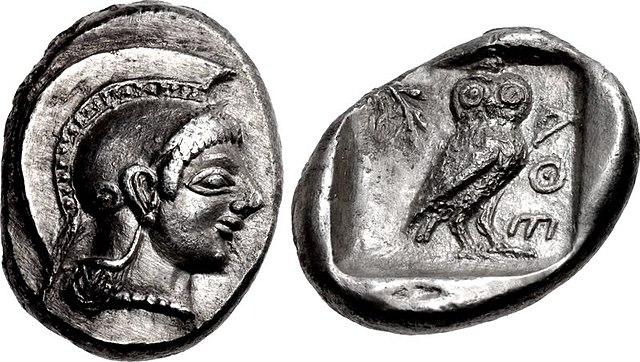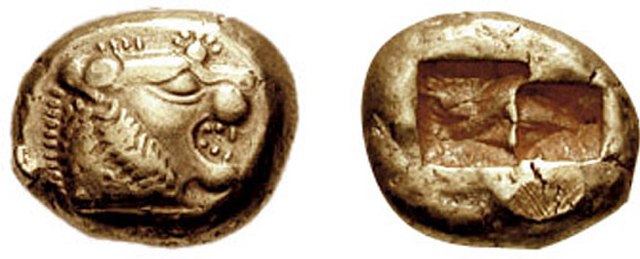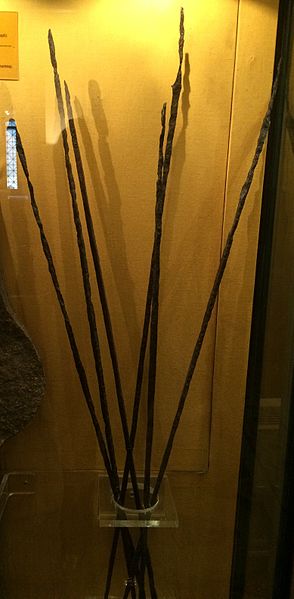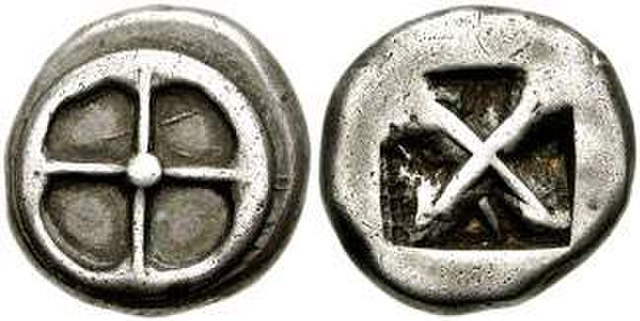The history of ancient Greek coinage can be divided into four periods: the Archaic, the Classical, the Hellenistic and the Roman. The Archaic period extends from the introduction of coinage to the Greek world during the 7th century BC until the Persian Wars in about 480 BC. The Classical period then began, and lasted until the conquests of Alexander the Great in about 330 BC, which began the Hellenistic period, extending until the Roman absorption of the Greek world in the 1st century BC. The Greek cities continued to produce their own coins for several more centuries under Roman rule. The coins produced during this period are called Roman provincial coins or Greek Imperial Coins.
The earliest coinage of Athens, c. 545–525/515 BC
Archaic coin of Athens with effigy of Athena on the obverse, and olive sprig, owl and ΑΘΕ, initials of "Athens" on the reverse. c. 510–500/490 BC
Above: Six rod-shaped obeloi (oboloi) displayed at the Numismatic Museum of Athens, discovered at Heraion of Argos. Below: grasp of six oboloi forming one drachma
Uninscribed electrum coin from Lydia, early 6th century BC. Obverse: lion head and sunburst Reverse: plain square imprints, probably used to standardise weight
In ancient Greece, the drachma was an ancient currency unit issued by many city-states during a period of ten centuries, from the Archaic period throughout the Classical period, the Hellenistic period up to the Roman period. The ancient drachma originated in the Greece around the 6th century BC. The coin, usually made of silver or sometimes gold had its origins in a bartering system that referred to a drachma as a handful of wooden spits or arrows. The drachma was unique to each city state that minted them, and were sometimes circulated all over the Mediterranean. The coinage of Athens was considered to be the strongest and became the most popular.
Above: Six rod-shaped obeloi (oboloi) displayed at the Numismatic Museum of Athens, discovered at Heraion of Argos. Below: grasp of six oboloi forming one drachma.
Athenian silver didrachm of "heraldic type" from the time of Peisistratos, 545–510 BC. Obverse: Four-spoked wheel. Reverse: Incuse square, divided diagonally.
Greek drachma of Aegina. Obverse: Land Chelone / Reverse: ΑΙΓ(INA) and dolphin. The oldest Aegina chelone coins depicted sea turtles and were minted ca. 700–550 BC.
Silver tetrobol (4/6 of drachma) from Massalia. Obverse: Artemis wearing stephane. Reverse: ΜΑΣΣΑ[ΛΙΗΤΩΝ] (of Massalians), lion standing right.








![Silver tetrobol (4/6 of drachma) from Massalia. Obverse: Artemis wearing stephane. Reverse: ΜΑΣΣΑ[ΛΙΗΤΩΝ] (of Massalians), lion standing right.](https://upload.wikimedia.org/wikipedia/commons/thumb/0/01/Massalia-21.jpg/640px-Massalia-21.jpg)